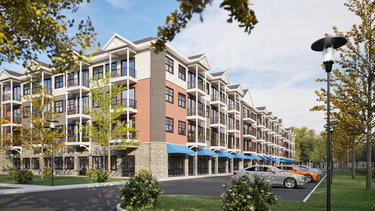Guilderland IDA adopts housing policy
— From Guilderland Village LLC submittal to the town of Guilderland
The developer of the proposed 260-unit Foundry Square previously agreed to set aside 20 percent of its units for workforce housing. The Guilderland IDA now has a policy in place to deal with developers offering such housing seeking agency assistance.
GUILDERLAND — The Guilderland Industrial Development Agency has adopted a formal policy for dealing with housing projects seeking financial benefits from the town.
At the policy’s core is its 25-80 rule, which says if a housing developer requests assistance from the IDA then at least 25 percent of its units are to be set aside for individuals who earn 80 percent of the Albany County area median income. The Department of Housing and Urban Development currently sets Albany County’s AMI at $116,100 — 80 percent works out to $92,880 per annum.
The agency began the process of defining workforce housing in April, after the 260-unit Foundry Square proposal included it as part of its submittal to the town; the project’s developer previously agreed to set aside 20 percent of Foundry Square’s units for workforce housing.
Workforce housing doesn’t have a hard-and-fast definition like affordable housing, defined by HUD as “housing on which the occupant is paying no more than 30 percent of gross income for housing costs, including utilities,” nor does the state law governing IDAs explicitly name housing in general as a project-type eligible for financial aid.
IDAs were primarily set up to boost business, create jobs, and prevent economic stagnation by supporting projects like factories, commercial buildings, and research labs. But development agencies across the state have embraced a 1985 comptroller’s opinion that suggests multi-family housing could be considered a “commercial project” eligible for IDA benefits if it demonstrably creates jobs or prevents economic deterioration.
However, state oversight bodies, like the Authorities Budget Office, have increasingly emphasized the need for justification beyond simply constructing apartments. An IDA must prove that a housing project meets the legal definition; fits its mission; and complies with clear agency policies, including a specific one for general workforce housing, something the Guilderland IDA previously lacked.
The Guilderland IDA examined policies from Dutchess, Suffolk, and Onondaga counties for its board to examine, drawing particular insight from Onondaga’s policy, portions of which were incorporated into Guilderland’s housing guidelines, and its specific definition for workforce housing.



